Kentucky Amish Near SMV Freedom?
The Kentucky Amish SMV situation has seen quite a few developments this week. On Tuesday the KY House Transportation Committee passed Senate Bill 75 by a count of 25-1, sending it to the House for full consideration. This bill would allow reflective tape in lieu of the SMV triangle. If it passes the House, it returns to the Senate for final passage. The last hurdle would be the governor’s signature.
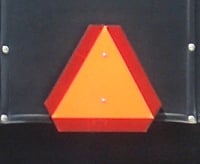
Yesterday, a separate amendment to the State Constitution passed the Kentucky Senate (Senate Bill 158). This bill “would require that the government have a compelling reason before it could infringe on anyone’s religious right”. According to the article the bill has its roots in a 1990 Oregon Supreme Court Case, but would have implications for the Kentucky Swartzentruber Amish.
Also yesterday, the SMV case came up before the Kentucky Supreme Court. During hearings the effectiveness of the triangle itself came into question:
“Do we have any real evidence that this triangle that the law imposes on the Swartzentruber family branch indeed does what it says what it’s supposed to do?” Justice Mary C. Noble asked Assistant Attorney General Christian Miller.
Miller said the sign draws attention to the buggy and can give a motorist a split-second warning that can mean the difference between “a 35 mile-per-hour collision … and a 15 mile-per-hour collision.”
“There is something that needs to be on the back of those buggies to draw people’s attention,” Miller said.
American Civil Liberties Union attorney Bill Sharp, an attorney for the Amish, said the law does not require bicycle or horseback riders to use the triangles “yet a six-foot-tall carriage that’s roughly the size of a compact car does have to have one.”
Whether by judicial ruling or legislative change, it sounds like chances are good KY’s Swartzentruber Amish will soon drive their triangle-less buggies without threat of fines or jail time.
According to the first article linked above Amish have already implemented requirements of Senate Bill 75. They’ve outlined both the back and sides of their buggies in reflective tape. Swartzentruber buggies are also carrying two lanterns, with one sitting a foot higher than the other, according to the stipulations of the bill.
Staggered or even lighting better?
On that last point, I’ve always wondered which in fact is more effective–level, even lighting, or the staggered arrangement in the Kentucky bill. On the one hand the even lights would imitate those of a car, something drivers are used to seeing on the road. On the other, the uneven positioning may indicate (to drivers who recognize the arrangement) that what lies ahead is not a car but a much slower-moving buggy.
But it seems like the uneven arrangement would rely on driver familiarity to be effective. An unfamiliar driver might be confused by what exactly he is seeing. I also wonder that if this uneven arrangement were superior, then why do other Amish not employ it via the positioning of their main rear lighting, which otherwise mimics that of cars.
The Amish illuminated
Buggy lighting of course varies among the diverse Amish groups. While plainer groups use minimal lighting, others boost visibility with an array of bulbs and blinkers. In an illuminating piece, Bruce Stambaugh writes about the work of the Amish Safety Committee in Ohio, a three-man group working to improve Amish road safety for the better part of 2 decades.
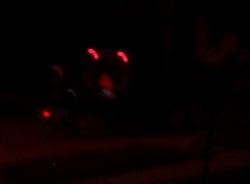
Committee member Wayne Hochstetler cites the blinking amber light as “the biggest help” in promoting visibility. This light is found at the top center of the buggy, and in some versions produces varied blinking patterns. Bruce also discusses the growing use of LED headlamps as well as reflective and even blinking safety vests among Amish pedestrians. Read it all here.
Finally, in a timely reminder that accidents aren’t always the fault of English drivers, an Amishman failing to yield caused an accident in Missouri yesterday, with both car and buggy driver landing in the hospital.


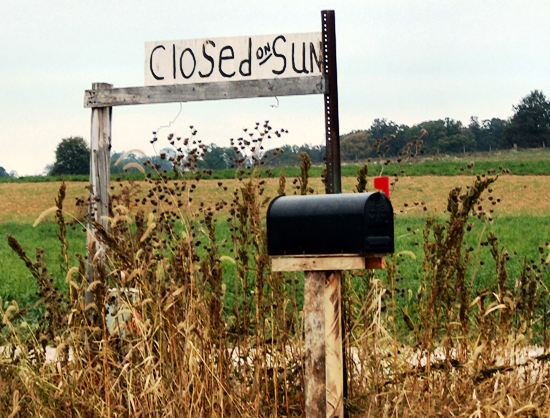


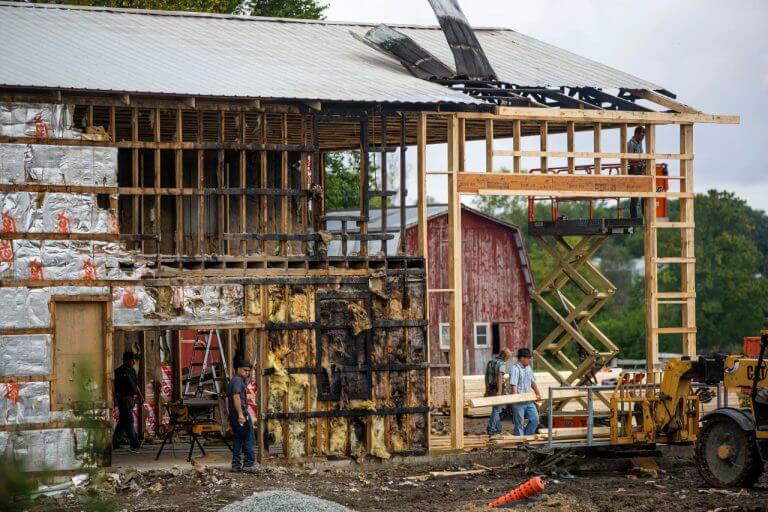
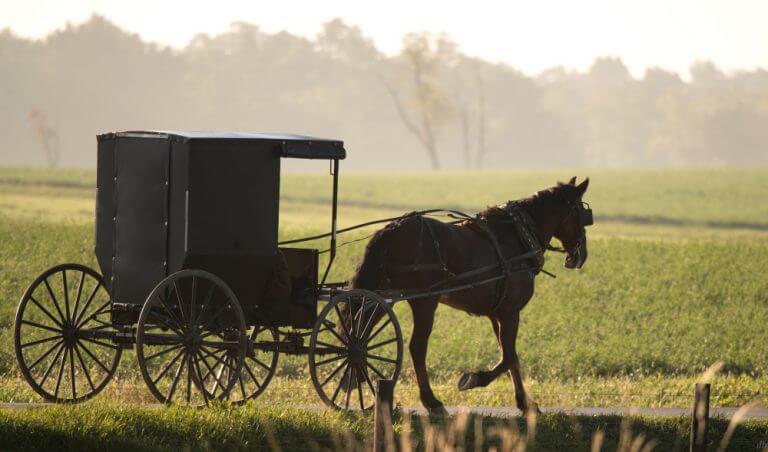
the American Civil Liberties Union .....................
First when i hear the American Civil Liberties Union is involved in anything i usually go the opposite way to whatever nonsense they are belching out, so they serve no purpose to me other than to argue for the sake of arguing. Now for what I’ve seen most of the Amish in my area who especially travel at night have their lights blinking so for me that really helps me see them on the road, now I’ve been behind some (Amish buggies) who decided not to do that and i didn’t see them until i was almost right on top of them! So regardless of the decision from the courts in my mind the Amish in Kentucky should have some reflective warning on the back of their buggies, and if they dont already have lights then that should be included as well. I’m very big on religious freedom but for me it can not trump safety for them or anyone else. That’s my 2 cents anyway. Richard
Thanks for keeping us posted about the status of this issue in Ky.
I have a question about “horse-and-buggy” history. In the early
1900’s when our country was making the transition between use
of horse-drawn vehicles and use of cars, what safety measures
were used then on horse-drawn vehicles? Did they have the orange
SMV sign then? When many people were driving cars, but some
were still driving horse-drawn vehicles were there many accidents?
I realize that when cars were first used, they were driven much,
much more slowly than today, but it seems like there still would have been a safety issue.
Hi Al. Just my opinion, but I doubt that, at that time, the roads were conducive to speeds greater than 25-30 mph. Cars were pretty rough rides, I would imagine. It seems to be the advent of straight, paved-surface roads that are so threatening to the safety of horse, buggy, and driver. Smooth, paved roads and comfortable vehicles (shocks/suspension) seem to be the culprit, to me, anyway.
Good question Al, and Lattice your response sounds pretty plausible though I haven’t done any research on that period of time. I like your insight about comfortable vehicles encouraging higher speeds, especially since I just traveled in a bus today that seemed to lack any sort of shocks or suspension. You could feel every pebble and road-bug 🙂
Amish safety and religion
Greetings!!
I have to agree with Richard in that safety needs to be a priority. I do sympathize with the Amish in their religious beliefs, however when driving in their buggies at night they need some measures of safety. I do not know if the lights being at different levels would help or not, especially with vehicle drivers who are unfamiliar with their use. I can picture myself slowing down at the site of unfamiliar lights but I cannot say the same for others.
In high traffic areas especially, I would like to see even more safety measures taken. SMV’s, reflective tape, lights. Everything possible to make the buggies more visable. I cannot imagine what I would feel like if I crashed into a buggy and killed someone simply because I did not see them!! And I am a very cautious driver. We have way too many reckless drivers on the road these days.
I do hope this is resolved to the best for everyone on the road, Amish and us outsiders alike.
Blessings, Alice
Buggy lighting layout--staggered vs. even
Alice I hope it is resolved as well, the contrast between the lowest Amish buggy lighting vs. the most technologically-friendly groups as you know is pretty stark, your “hometown” (or close to hometown) Amish near Arthur are among the more lit-up buggies on the roads.
What I was thinking with the staggered form of lighting is that it might confuse a driver’s sense of perspective, with one light perhaps seeming further down the road. I’m pretty sure it would be a unique positioning, does any other road vehicle place their lighting in an asymmetrical fasion like that?
So in asking the question I do wonder if any tests have been done comparing the two forms of lighting, as they have been done with other buggy safety implements. What has led them to that stipulation? It didn’t originate with Kentucky lawmakers, as other Swartzentruber Amish do hang their lamps in such fashion. But I wonder what originated that practice–someone’s hunch, hard evidence or something else? I do not know the answer to that.
Facts
I live in KY near the Amish that are being jailed. They use 109″ of highly reflective tape now and the SMV triangle is only 79″ of reflective material. They can bee seen at night because of the photo’s I’ve taken and those are the same photo’s used by KY Senator Ken Winters, the Transportation Committee couldn’t believe how much reflection the tape put off compared to the triangle. One of the reason the Transportation committee is in favor of the tape vs. the triangle. We put two buggies side beside, one with the triangle and one with tape. Unbelievable how much difference there is. Also, the will be required to use the tape on the sides and front of the buggy. In roads have the yellow signs warning that there are buggies in the area, same as the school crossing signs. Some people need to just slow down and “SEE THE SIGNS”. This group of Amish are the most strict of any of the Amish. This reflective tape would help see the buggy’s on a hill crest unlike the triangle, the tape will outline the whole back of the buggy and the triangle is only 3′ off the ground, to low to see until you are at the crest of the hill. Some comment and have never seen this tape at night. Just my 2 cents worth.
Thanks for your factual input
As was pointed out above, the reflective tape is BRIGHT under the shine of headlights. The tape is placed around the outer edge of the buggy and therefore not concentrated in one spot like the SMV sign. The SMV is only more visible during daylight. The reflective tape is brighter at night and higher up on the buggies so that a buggy going over a hill is illuminated before a SMV symbol equiped buggy would be. SMV symbols and flashing lights do not prevent accidents, especially in this world of distracted or impaired drivers. The effect of SMV symbols has proven to be only minor with preventing or reducing farm equipment accidents and I believe it is the same with buggies.
We, the people forcing these ‘safety’ devices upon unwilling subjects, need to be more humble, and believing that God is in control, that he will prevent or allow an accident as is according to His Will for his people. We cannot control God with signs. His Will be done and to God be the Glory.
Reflective tape vs. SMV triangle on Amish buggies
The argument for reflective tape vs. the SMV triangle does seem convincing. It’s worth remembering that for many Amish the SMV triangle is just one element of an entire visibility regimen including a range of lights and reflectors. But if you had to choose only one, I’m open to the idea that the tape is superior to the SMV, particularly given the hills and changing elevation aspect.
I’ve been going through old Family Life clippings lately and have hit upon a number of buggy safety articles, from the early 90s and earlier. I read mention of *black* reflective tape which surprised me as I was under the impression that it was mainly silver or white in color. Perhaps that is just a descriptive term used by the writer.
Blinking lights
I thought that blinking lights tended to attract the attention of drunk drivers, and then the drivers drove towards the blinking lights, thus increasing the possibility of a crash and injuries. I vaguely remember reading this as an academic study that was published in the early 1990’s.
Katrina, I had never heard that, but interesting. That sounds like a pretty intoxicated driver though.
She is correct ...
My (much) older brother is a retired police officer. He worked for the PD in a major city for about 30 to 35 years; with about 20 of that as an accident investigator. How would you like to spend the entire day, every day investigating automobile accidents?
Anyway, he told me one time that when drunk drivers get to a certain level of inebriation they are drawn to taillights instead of taking measures to avoid them. He said that if they get drunk enough they will actually even be drawn to flashing lights too; just like Katrina mentioned. That is really encouraging, isn’t it?
Reflective triangles in the evening’s twilight
I sort of think that its like when Englishers invented the automobile, I figure most people thought it needed a warning system because it went comparatively fast; the opposite of the Amish dilemma.
Look both ways, listen for the clatter of horses hooves, and watch for reflective pieces as you cross the street and walk into the evening’s twilight everyone.
~ SHOM
Shom I brought this issue up in one of my classes in a roundabout discussion (we were actually talking about driverless cars) and a student mentioned something about a warning bell on early autos sounding the alarm for pedestrians ahead…I’m not sure of the veracity of that claim but seems like I’ve heard something along those lines.